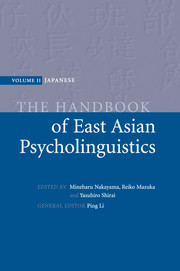Book contents
- Frontmatter
- Contents
- List of figures
- List of contributors
- In memory of Miwa Nishimura
- Preface
- Introduction
- Language acquisition
- 1 Ontogeny of language
- 2 Caregivers' speech
- 3 The intrinsic link between gesture and speech at the prelinguistic stage
- 4 Infant speech perception
- 5 Phonological acquisition
- 6 The mechanism of lexical development: implications from Japanese children's word learning
- 7 The acquisition of nouns and verbs in Japanese
- 8 The acquisition of verbal nouns
- 9 The acquisition of Japanese numeral classifiers
- 10 The acquisition of case markers
- 11 The acquisition of tense and aspect
- 12 On the origin of children's errors: the case of Japanese negation and direct passive
- 13 Binding Theory in UG and first-language acquisition of Japanese
- 14 The acquisition of the particles ne, yo, and no
- 15 The acquisition of linguistic politeness in Japanese
- 16 Children's narrative structures
- 17 Memory talk and testimony in children
- 18 Developmental dyslexia
- 19 Japanese Sign Language
- 20 The role of an innate acquisition device in second-language acquisition
- 21 Japanese, the grammar of reflexives, and second-language acquisition
- 22 Processes in L2 Japanese sentence production
- 23 The development of lexical competence among second-language readers
- 24 Reading in Japanese as a second language
- 25 Intrasentential code-switching in Japanese and English
- Part II Language processing
- References
- Name index
- Subject index
16 - Children's narrative structures
from Language acquisition
Published online by Cambridge University Press: 05 June 2012
- Frontmatter
- Contents
- List of figures
- List of contributors
- In memory of Miwa Nishimura
- Preface
- Introduction
- Language acquisition
- 1 Ontogeny of language
- 2 Caregivers' speech
- 3 The intrinsic link between gesture and speech at the prelinguistic stage
- 4 Infant speech perception
- 5 Phonological acquisition
- 6 The mechanism of lexical development: implications from Japanese children's word learning
- 7 The acquisition of nouns and verbs in Japanese
- 8 The acquisition of verbal nouns
- 9 The acquisition of Japanese numeral classifiers
- 10 The acquisition of case markers
- 11 The acquisition of tense and aspect
- 12 On the origin of children's errors: the case of Japanese negation and direct passive
- 13 Binding Theory in UG and first-language acquisition of Japanese
- 14 The acquisition of the particles ne, yo, and no
- 15 The acquisition of linguistic politeness in Japanese
- 16 Children's narrative structures
- 17 Memory talk and testimony in children
- 18 Developmental dyslexia
- 19 Japanese Sign Language
- 20 The role of an innate acquisition device in second-language acquisition
- 21 Japanese, the grammar of reflexives, and second-language acquisition
- 22 Processes in L2 Japanese sentence production
- 23 The development of lexical competence among second-language readers
- 24 Reading in Japanese as a second language
- 25 Intrasentential code-switching in Japanese and English
- Part II Language processing
- References
- Name index
- Subject index
Summary
Narrative, or the verbal representation of events, is an important aspect of linguistic expertise that differs from phonology, morphology, syntax, or semantics. Narratives, personal narratives in particular, are spoken by everyone everywhere. Even if the act of telling personal narratives is universal and ubiquitous, however, how to tell and interpret narratives should be regarded as an activity with deep cultural roots. There undeniably exist starkly culture-specific narrative styles. We meet individuals from other cultures with speech styles that we find difficult to understand. Anthropological studies (e.g. Ochs & Schieffelin, 1984), in fact, have argued that different cultures adopt distinct approaches in talking with children about past events. Studying young children's performance with narratives can help us identify evidence of their cognitive and linguistic skills development in a particular culture. For this reason then, investigating how children learn to narrate and how they structure their personal narratives is a worthy endeavor.
This chapter explores how language shapes and is shaped by culturally specific experiences through analysis of: (1) how young children develop narrative structure, and (2) how parents guide their children in the acquisition of culturally appropriate styles of narrative and literacy.
Different approaches to narrative analysis
Narrative is a superordinate term that includes a variety of forms, such as scripts, personal event narratives, and fictional stories (Ninio & Snow, 1996). Sometime during the second year of life children begin to utter their first words. During the following four to five years, language acquisition and development occur quite rapidly.
- Type
- Chapter
- Information
- The Handbook of East Asian Psycholinguistics , pp. 116 - 122Publisher: Cambridge University PressPrint publication year: 2006



